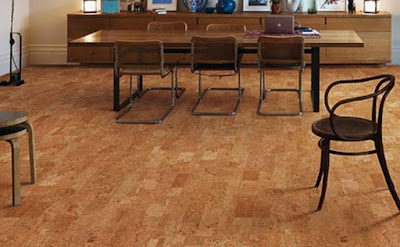Most of us don’t think of cork being used beyond making of bottle stoppers, but it’s increasingly being used as a building material.
It may not be noticeable, but cork is being used as a flooring material, especially for more frequently visited public buildings like churches, hospitals, hotels, libraries and schools. It has inherent characteristic to buffer noise and being resilient in nature it provides comfort when walked over.
Cork is a derivative of the outer bark of the cork oak tree, Quercus
suber, which is usually cultivated in the Mediterranean. Portugal
produces fifty percent of the world’s requirements of cork. The other
contributing countries are: Algeria, Spain, France, Italy Morocco, and
Tunisia. The trees are treated as valued possessions by the cork
producing countries. That’s because cork is a major export material and
therefore availability of vast expanses of these trees provides
employment to local populace while earning foreign exchange for the
country.
It takes nine to ten years for the bark of a cork tree
to be ready for harvesting. The harvest is cleaned and boiled to get rid
of the outer bark. The best quality produce is reserved for making cork
bottle stoppers.
Modern manufacturing processes and techniques
enable total utilization of the raw material and no part of it goes as a
waste. Whatever is left after making of stoppers for bottles is
grounded to make small granules. These are then mixed with suitable
binding agents to get large molded blocks. Finally the blocks are baked
to get natural cork material that finds its way to construction
industry. Also, the cork floor tiles are a great option for saving
material.
Cork finds many applications and is often used in
flooring, walls and ceilings. It can be molded to give different shapes.
As it has the properties to resist moisture, mold and rot-resistant
properties it is a preferred medium for floors of more frequently
visited buildings and residences. Many modern houses make use of this
material.
Why is cork such a favorite in the construction of modern buildings?
Its application as a flooring underlay reduces noise by up to fifty decibels. So, it helps to reduce noise levels to a good extent. Apart from that, it enjoys a wide patronage for the following factors:
* Durable. Cork has natural resistant properties and pulls thru compression to regain its natural shape. If provided with a protective finish, this feature further improves.
* Provides thermal and moisture insulation. Cork cells have flexible cellular walls and are held together in a honeycomb manner that makes it airtight and very resistant to moisture and temperature changes.
* Provides underfoot comfort. Because of its characteristic nature to regain its shape from compression, it provides a cushioning affect to feet when walked over.
* It’s Easy to clean and maintain. Cork flooring is the easiest to clean. Flooring with wax finish can be cleaned in a jiffy by using a dry or moist mop. Periodic application of wax keeps its shine. However, better cleaning can be achieved by employing an electric buffing with 00 steel wool discs. Subsequently, lamb’s wool pads may be used.
Use of dry or damp mop can solve the purpose of routine cleaning for polyurethane finished cork flooring. Refinishing is achieved by using power floor machine with 00 wool disc followed by the application of polyurethane as per prescribed directions.
The manufacturing process of cork hardly causes any ill effects on the environments.
Countries producing cork impose strict laws for its harvesting and manufacturing. The trees are so harvested that they survive the process and manufacturing processes are so adopted that cause zero waste.





Post a Comment